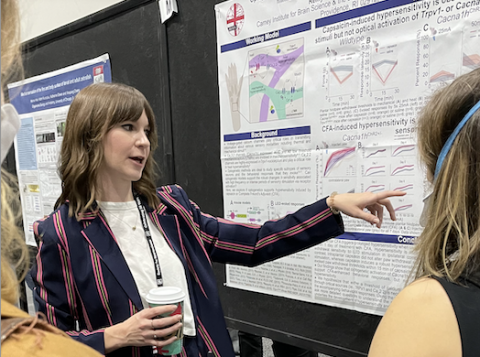
If you weren’t able to make it this year or if you lost track of Carney amidst the throng 40,000+ attendees, here are a few insights and images from this year’s event:
Diane Lipscombe, Director of the Robert J. and Nancy D. Carney Institute for Brain Science, Director of the Center for Alzheimer's Disease Research, Thomas J. Watson, Sr. Professor of Science, Professor of Neuroscience
Just being there together with neuroscientists from across the world was fabulous. There was a large number of trainees from undergrads through to postdocs and they brought boundless energy and excitement to share their research. The presidential lectures were fabulous, from the sense of touch to escaping from predators to sleep to the facial recognition centers in the brain.
On the last day of the conference in the afternoon, I went to a session on statistical testing under the category of "Dual Perspectives in Neuroscience". The question "Should we abandon statistical significance testing in neuroscience?" drew a packed room and an interesting debate. You might wonder why, with so many interesting discoveries and sessions I would highlight this one? As a field, we put much effort into developing hypotheses, developing experimental approaches, gathering data, but far less effort into data interpretation that is statistically valid. A P value of less than 0.05 is all too often used as the threshold of "significance". It's taken on a mystical quality, veering too far from sound scientific reasoning. Both presenters agreed on the rampant misuse of P values but Brad Alger, from the University of Maryland School of Medicine, argued for a strategy that not only maintains but improves significance-based approaches and retains P values but uses them correctly. Bob Calin-Jageman of Dominican University argued for widespread use of estimation-based approaches and only favored the use of P values in the minority of published studies.
The message was clear, we have to wean ourselves from the arbitrary use of P values and start to apply sound statistical reasoning.
Christopher Moore, Associate Director of the Robert J. and Nancy D. Carney Institute for Brain Science, Professor of Neuroscience
A definite conference highlight was the National Science Foundation meeting “NeuroNex IV: Beyond Neurons.” Justine Allen (Program Manager of the NSF NeuroNex Technology Hub) and I were the organizers, and Diane and John Davenport (Carney’s Director of Research Strategy) were also workshop leaders and many students also presented posters. All of it was great, but the workshops were a highpoint: 100+ world-class scientists brainstorming to envision the future was amazing. They were coming up with entirely new ways to study the brain and expanding our view of the body networks that make behavior.
Ines Tomas Pereira, Associate Director of Administration & Finance
The SfN annual meeting is always a feast for the senses, considering the number of people, the amount of new research being shared, the wonderful food and social interactions. But this year it felt particularly intense, after several years of avoiding crowded environments. Still, it was as reinvigorating as ever. My favorite moment of the conference was watching John O'Keefe, discoverer of hippocampal place cells, Nobel prize winner, present his own poster right there amongst the trainees.
Kristin Webster, Assistant Director of Training and Development
One of the best things about SfN is that because it is so large and appeals to scientists across all fields of neuroscience, people from all over the world attend. I got to reconnect with two close European friends from my postdoc at the MRC Laboratory of Molecular Biology in Cambridge, England. Typically we're only in our postdoc cities for a few years, so even if I visited Cambridge now, I wouldn't be able to reconnect with most of the people I worked with. So I'm thankful we all were able to attend SfN 2022 and catch up over tacos and margaritas (and posters)!
And, of course, SfN is always great for picking up neuron-themed swag to decorate my office! This year I came home with brain-shaped paper clips, neuroscience-themed temporary tattoos, fun neuroanatomy postcards, and a new brain pin from my favorite science artist.